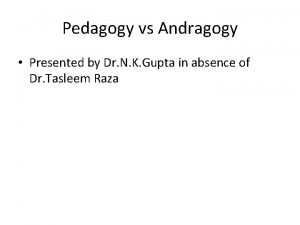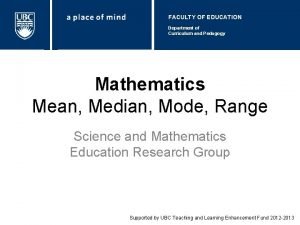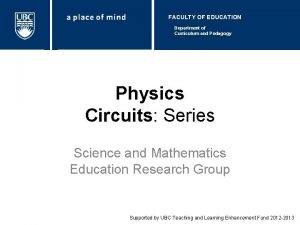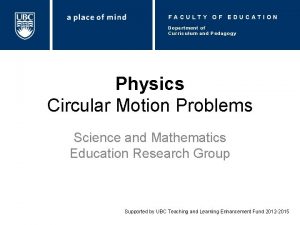FACULTY OF EDUCATION Department of Curriculum and Pedagogy
















- Slides: 16

FACULTY OF EDUCATION Department of Curriculum and Pedagogy Mathematics Geometry - Diagonals Science and Mathematics Education Research Group Supported by UBC Teaching and Learning Enhancement Fund 2012 -2013

Diagonals Title Question

Diagonals Title I Question A. a B. 2 a C. a/2 D. 12 a E. No idea A wireframe model of a cube is in front of you. Each side has length a. What is the length of the blue line?

Solution Comments Answer: A Justification: The side length is a. The blue line is a side. The answer is a.

Diagonals Title II Question A. √a B. 2√a C. √ 2 a D. 2 a E. No idea A wireframe model of a cube is in front of you. Each side has length a. What is the length of the green line?

Solution Comments Answer: C Justification: Using the Pythagorean theorem, where a 2+b 2=c 2, we see that a 2+a 2=l 2 where l is the length of the green line. Taking the square root of both sides we get l=a√ 2, which is our answer. Remark: The following questions will become much easier when trigonometry is learned, but that is not the point of this problem set. Also, unless the radical has brackets following it, the radical is only applied to the first number, i. e. √ 2 a=(√ 2)a≠√(2 a).

Diagonals Title III Question A. √a B. 3√a C. √ 3 a D. 2 a E. No idea A wireframe model of a cube is in front of you. Each side has length a. What is the length of the red line?

Solution Comments Answer: C Justification: Again, we use the Pythagorean theorem. We can see the right triangle with the green line and blue line as sides. Since we know the green line has a length of √ 2 a, l 2=a 2+(√ 2 a)2, where l is the length of the red line. Therefore, l=√ 3 a, which is the answer.

Diagonals Title IV Question A. 2√ 3 a/3 B. a/2 C. √ 3 a/2 D. √ 3 a E. √a A wireframe model of a regular tetrahedron is in front of you. Each side has length a. What is the length of the blue line that bisects the equilateral triangle?

Solution Comments Answer: C Justification: Look at the image below. The blue line constitutes a triangle with a/2 as the base and a as the hypotenuse. Using Pythagoras’ theorem, we find that l 2+(a/2)2=a 2, l 2=3/4 a 2, and l=√ 3 a/2. a l a/2

Diagonals Title V Question A. √ 3 a/3 B. √ 3 a C. 2√ 3 a/3 D. √ 3 a/2 E. √ 3 a/4 A wireframe model of a regular tetrahedron is in front of you. Each side has length a. What is the length of the red line if all four lines in the tetrahedron are equal and connected to the center?

Solution Comments Answer: A Justification: From the right triangle in the image below, we can see that (√ 3 a/2 -l)2+(a/2)2=l 2. Expanding we get 3 a 2/4√ 3 al+l 2+a 2/4=l 2. Simplifying, this is √ 3 al=a 2. l is therefore a/√ 3=√ 3 a/3. l a √ 3 a/2 l √ 3 a/2 -l a/2

Diagonals Title VI Question A. √ 3 a B. √ 3 a/2 C. √ 6 a/2 D. √ 6 a/3 E. √ 3 a/√ 3 A wireframe model of a regular tetrahedron is in front of you. Each side has length a. What is the length of the purple line that goes from the top vertex to the center of the base?

Solution Comments Answer: D Justification: Splitting the tetrahedron in half and looking at the cross section, we see that the green trisectional lines and the edge of the tetrahedron make a right triangle with the purple line. From this we know that a 2 -(√ 3 a/3)2=l 2, where l 2=2 a 2/3, l=a√(2/3)=√ 6 a/3. a √ 3 a/2 l √ 3 a/3

Diagonals Title VII Question A. √ 3 a B. √ 3 a/2 C. √ 6 a/2 D. √ 6 a/3 E. √ 3 a/√ 3 A wireframe model of a regular tetrahedron is in front of you. Each side has length a. What is the length of the red line if all four lines in the tetrahedron are equal and connected to the center?

Solution Comments Answer: C Justification: Splitting the tetrahedron in half and looking at the cross sectional view, we can see that (√ 6 a/3 -l)2+(√ 3 a/3)2=l 2. Expanding we get 2 a 2/3 -√ 6 al/3+l 2+a 2/3=l 2. Simplifying, this is √ 6 al/3=a 2. l is therefore 3 a/√ 6=√ 6 a/2. l √ 3 a/2 a √ 6 a/3 -l l √ 3 a/3
 Education scotland play pedagogy toolkit
Education scotland play pedagogy toolkit Gde curriculum
Gde curriculum Nit calicut chemistry
Nit calicut chemistry Ga tapp program
Ga tapp program Definition of sport pedagogy
Definition of sport pedagogy Advanced pedagogy and application of ict
Advanced pedagogy and application of ict Epistemology and pedagogy
Epistemology and pedagogy Importance of faculty in higher education
Importance of faculty in higher education Myfile yorku
Myfile yorku Feri maribor
Feri maribor Uvu professor salary
Uvu professor salary Faculty of education khon kaen university
Faculty of education khon kaen university Techno pedagogy
Techno pedagogy Public pedagogy definition
Public pedagogy definition Pedagogical vs andragogical
Pedagogical vs andragogical Peda gogy
Peda gogy Example of equity pedagogy
Example of equity pedagogy































